Michael Greger's Blog, page 9
February 25, 2025
How Healthy Are the Impossible Burger and Beyond Meat vs. Beef?
What happens when you compare the trans fats, saturated fat, sodium, and cholesterol levels in plant-based meats versus animal-based burgers?
Global meat production has skyrocketed over the last half-century. As you can see below and at 0:20 in my video Are Beyond Meat and the Impossible Burger Healthy?, pork and poultry meat now exceed 100 megatons—that’s 100 million tons—a year, and “our growing demand for meat and dairy food products is unsustainable.”
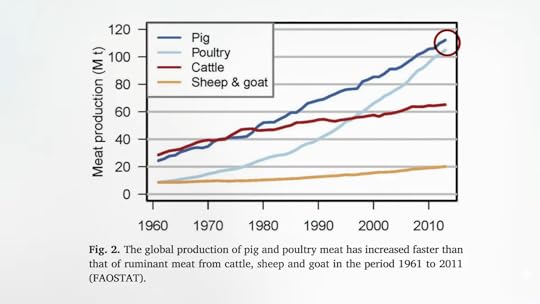
“Anti-consumption and/or reduction of meat and animal by-products are arguably the most impactful ways in which consumers can alter their diets to positively impact individual and societal well-being.” Interest in plant-based diets and meat reduction is definitely growing, but even something like Meatless Mondays “requires dietary change and neither sustainability nor health approaches are likely to work with those who have strong positive beliefs about meat eating.” However, swapping in plant-based meat alternatives “may help disrupt the negativity around reducing meat.” For hardcore meat eaters, though, the substitutes have to taste like meat and look like meat.
It’s interesting. The more people consume meat substitutes, the less likely they are to care that they have similar tastes, textures, appearances, or smells of meat, as you can see here and at 1:04 in my video.

But for plant-based alternatives to appeal to those who need them, the meatier, the better. This has certainly been accomplished with the spate of new plant-based products on the market, and study after study after study agree that they’re healthier for the planet. Are they healthier for us, too?
As you can see below and at 1:30 in my video, when the labels of beef, Impossible, and Beyond burgers were compared and four of the worst components of the food supply—trans fats, saturated fat, sodium, and cholesterol—were assessed, the plant-based burgers won hands down when it came to trans fat and cholesterol. We all know that trans fats are “a serious risk factor to cardiovascular disease, cancer, and diabetes,” but they’ve also been associated with symptoms of depression, a lowering of testosterone in men (even at just 1 percent of calories), as well as linked to “a greater risk of developing all-cause dementia and Alzheimer disease.” Indeed, higher levels of trans fat in our blood are associated with up to a 50 percent higher risk of developing dementia, including Alzheimer’s.
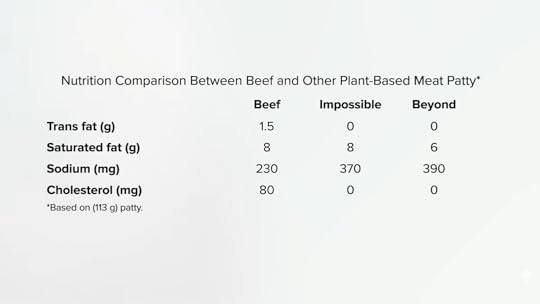
Now that partially hydrogenated oils have been phased out of the food supply in the United States, for example, the only major source of trans fats that remains will be animal products.
What is the tolerable upper daily intake level for trans fat? An upper limit was not set for trans fat by the Institute of Medicine (IOM) “because any incremental increase in trans fatty acid intake increases CHD risk,” and coronary heart disease is the number one killer of men and women. That is, any intake of trans fat above zero “increases LDL cholesterol.”
Because trans fatty acids are unavoidable in diets that contain meat and dairy, consuming zero trans fat “would require significant changes in patterns of dietary intake.” One of the authors of the Institute of Medicine’s report is from the Harvard School of Public Health’s nutrition department and offered a memorable explanation for why the IOM panel did not cap it at zero: “‘We can’t tell people to stop eating all meat and all dairy products,’ he said. ‘Well, we could tell people to become vegetarians,’ he added. ‘If we were truly basing this only on science we would, but it is a bit extreme.’” (We wouldn’t want scientists to base anything on science…)
Anyway, plant-based meats being trans-fat-free is a big advantage, and, of course, they’re free of cholesterol, hormones, and antibiotics, and have not been designated as “probable human carcinogens” by the World Health Organization, as you can see here and at 3:30 in my video.

Now, I’m not happy with the plant-based burgers’ added salt, which is about a quarter of the American Heart Association’s 1,500-mg daily upper sodium limit, or their saturated fat (from added coconut oil), but those do seem to be outliers. In the largest study of the nutritional value of plant-based meats to date, saturated fat levels of similar products only average about 2 grams per serving, which is much better than the animal-based equivalents. Sodium remains a problem throughout the sector, though, like nearly any other processed food out there, as seen here and at 4:03 in my video.
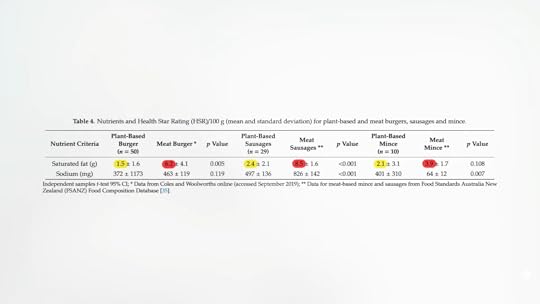
How processed are these products? Let’s look at the fiber content, for example. Seeing any fiber in a burger is a good thing, but if we ate the same amount of protein from yellow peas, for example, the primary plant protein in Beyond Burger, there would be almost no saturated fat or sodium at all, and we’d get a full 20 grams of fiber, as seen here and at 4:25 in my video.
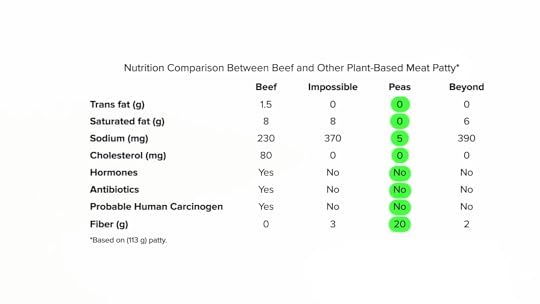
Processing plants in a processing plant can eliminate 90 percent of the fiber, but processing plants through animals eliminate 100 percent of the fiber.
As the chair of Harvard’s nutrition department put it, “Nutrition policies and dietary guidelines should continue to emphasize a diet rich in plant-based foods such as nuts, seeds, and legumes or pulses, which are rich in protein and many other nutrients but require little industrial processing.” But we shouldn’t let the perfect be the enemy of the good. Not everyone can go all kale and quinoa overnight. The choice on a U.S. Burger King menu isn’t between a beef Whopper and soybeans (a primary ingredient in the Impossible patty), but between a beef Whopper and an Impossible Whopper, and in that case, it’s a no-brainer.
If you missed the first video in this series on plant-based meats, see The Environmental Impacts of Plant-Based Meat Substitutes.
Stay tuned and check more videos in the related posts below.
For a healthful, whole-food veggie burger, check out my recipe for Black Bean Burgers from my first cookbook.
February 20, 2025
What Are the Environmental Impacts of Plant-Based Meats?
Environmental assessments of 50 different plant-based meats show them to be vastly more sustainable than animal-based meats.
“There is increasing consensus that transitioning towards reduced meat consumption and more plant-based diets is a key feature to address important health and sustainability challenges” that humanity is facing, yet the graph below and at 0:25 in my video The Environmental Impacts of Plant-Based Meat Substitutes shows that the trajectory of global meat consumption has increased.
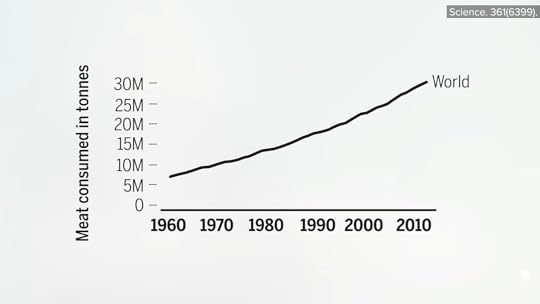
According to the Food and Agriculture Organization of the United Nations, “we will have to double the production of meat and dairy to meet the predicted demand for animal proteins in 2050.” However, we would have to do the exact opposite to contain the ecological damage and “environmental impact of livestock.”
“Nearly every credible forecast shows that if we’re to have any chance of meeting future food in a sustainable fashion, lowering our meat consumption will be absolutely essential.”
More centralized governments may be effective in influencing consumption patterns. For example, the “Chinese government has outlined a plan to reduce its citizens’ meat consumption by 50%,” but since the main drivers of global meat consumption are factors such as rising incomes, urbanization, and Western culture, the “main identified drivers of meat demand are difficult to influence through direct policy intervention.” Thus, we must take our case directly to the consumer. However, information and education may not be enough. We may need the “increased availability of ready-made plant-based products.”
Too often, alone, “ethics and sustainability does not stand much of a chance in a world of consumers…Many consumers seem deaf to ethical arguments…[that] are quickly forgotten when one is buying food.” When it comes to “consumers’ perceived barriers to following a plant-based diet,” the largest barrier may simply be “meat appreciation,” enjoying the taste of meat. So, in practice, if we want people to shift to plant-based options, “the taste, structure and nutritional value of vegetarian meals could be developed to more closely follow the preferences of meat eaters.” Why design a veggie burger primarily for vegetarians? They’re already not eating meat. When Patrick Brown founded Impossible Foods, “his goal was to create something a burger lover would say is better than any burger they’ve ever had.’” Also in the marketplace is “the Beyond Burger, created by Beyond Meat, a company founded to tackle climate change by creating vegan products free from meat and animal by-products” that are “Juicy, Meaty and Delicious.”
But are they better for the climate? If so, how much better? Reputable groups have published environmental lifecycle assessments covering the Impossible Burger and the Beyond Burger, and I did a short piece for the Swiss investment firm UBS summarizing the results, as you can see below and at 2:48 in my video.
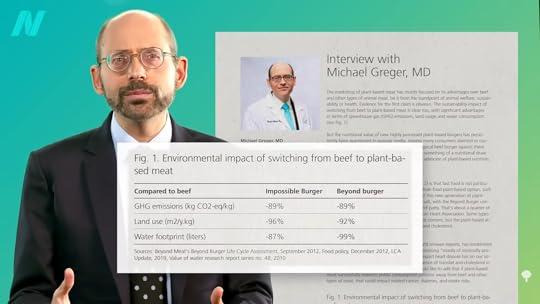
Indeed, switching to either plant-based meat option, the Impossible Burger and the Beyond Burger reduce greenhouse gas emissions, land use, and water footprints by about 90 percent, compared to beef.
Similar lifecycle analyses have been performed on more than 50 different plant-based meats. All such studies found them to be vastly more sustainable than meat and processed meat products, with no real differences in greenhouse gas (GHG) emissions observed between the different sources of protein used in the plant-based meats, whether wheat, soy, or another. Though, obviously, any products containing eggs would be significantly worse with “significantly higher amounts of GHG.”
Now, of course, if we went straight to the unprocessed peas and soybeans from which the Beyond and Impossible Burgers are made, we wouldn’t get just a 90 percent lower environmental impact, but around a 99 percent lower impact. That impact drops to zero, however, if no one is willing to eat it.
A review of consumer research on meat alternatives found that although considerations like “health, environmental and animal welfare aspects can persuade consumers and influence their decision to try a meat substitute, the appearance, and taste of those meat substitutes are crucial factors for their consumption on a regular basis.”
Interestingly, these days, plant-based foods may actually have a leg up. Researchers gave omnivorous college students both animal- and plant-based chocolate milk, macaroni and cheese, chicken tenders, and meatballs, but told them they were actually all made from plants. The researchers “surprisingly and unexpectedly found that when subjects tasted the food and rated how much they liked the taste, those who were told the food was vegan liked the food significantly better than did those who were told the food was of animal origin. Thus, thinking a food was vegan actually increased liking for the taste of that food.”
Other demographics may have a different reaction, though, in which case there is always “sustainability-by-stealth,” using blended products that substitute some of the animal protein for plant protein. Recently, such “hybrid products (meat analogs in which part of the meat is replaced by plant-based ingredients) have made a promising entrance,” so much so that Perdue and Tyson, two major meat producers, are bragging about the incorporation of plant protein into their blended products, as you can see here and at 4:41 in my video.

This is from the first of nine videos in a series on plant-based meats, which includes the titles in the related posts below.
For background on food and climate change, see Diet and Climate Change: Cooking Up a Storm.
February 18, 2025
Why Is Sorghum One of My New Favorite Grains?
Learn why sorghum is one of my favorite new grains.
“Despite playing a significant role in Africa and Asia as a staple grain, sorghum has only recently emerged as a potential human food source in the developed world.” And it isn’t just a principal grain in many parts of the world, but it’s “critical in folk medicine” traditions, too. What might its health benefits be? There are some in vitro data from test tubes and petri dishes, as well as in vivo data, meaning “within the living” in laboratory animals, but only in the last decade have we started seeing human trials.
In one study, participants were asked to eat sorghum pancakes or corn pancakes for supper every day for three weeks. Both groups saw significant, 20 to 30 percent drops in their cholesterol, but all participants were also “requested not to consume eggs and other cholesterol-boosting foodstuff,” so that may very well have played a role.
Another study used biscuits. Those eating sorghum biscuits said they felt more satiated than when they ate wheat biscuits, but that “did not translate to differences in intake at the subsequent ad-libitum [all-you-can-eat] meal.” So, does it matter that they subjectively felt more satiated if that did not cause them to eat any less? Unsurprisingly, when put to the test, those eating sorghum versus wheat biscuits didn’t lose any weight, though the data are a bit mixed. A recent study concluded that “sorghum can be an important strategy for weight loss in humans.” However, those in the sorghum group didn’t actually lose more weight. They did eat hundreds more calories a day, though, and they still lost more body fat, as you can see below and at 1:41 in my video The Health Benefits of Sorghum.
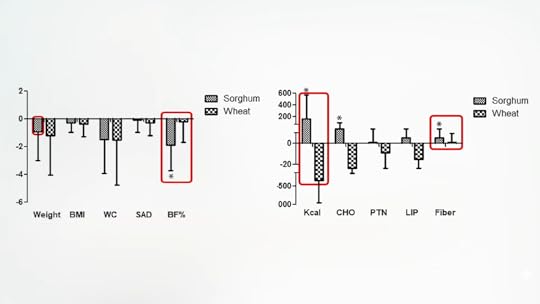
This may be because of their greater fiber consumption or intake of other goodies, like the resistant starch in sorghum. The vehicle the researchers used was an artificially flavored, colored, and sweetened powdered drink mixture of water, milk powder, and either sorghum or wheat flour. That may be good for a study since you can make a blinded control, but it leaves you wondering what would happen if you actually ate the whole food.
The resistant starch is exciting, though. Most of the starch in sorghum is either slow-starch—that is, slowly digestible—or fully resistant to digestion in the small intestine, which offers a banquet bounty of prebiotics for our good gut flora down in our colon. Evidently, it isn’t the sorghum starch itself, but interactions with the proteins and other compounds that effectively act as starch blockers, inhibiting our starch-munching enzymes. Sorghum ends up with “the lowest starch digestibility” among grains, which is why, traditionally, it was considered to be an “inferior” grain—but inferior in the sense of not providing as many calories. (That’s a good thing in the age of epidemic obesity.)
When study participants were given either a whole-wheat muffin (the control) or a sorghum muffin, with both containing the same amount of starch, researchers saw significantly higher blood sugars 45 minutes to two hours after subjects ate the wheat muffin, as shown below and at 2:58 in my video.

They also saw a higher insulin spike, starting almost immediately after consuming the wheat muffin, as seen below, and at 3:03.
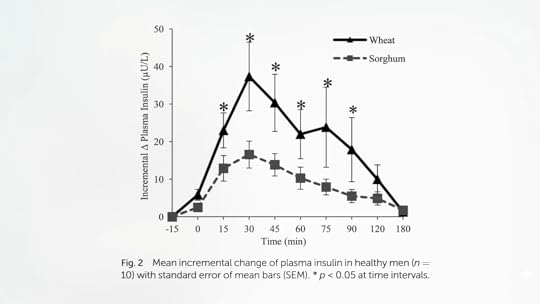
Overall, after consumption of the sorghum muffin, researchers found a 25 percent lower blood sugar response, and the participants’ bodies had to release less than half the insulin to deal with it, as seen here and at 3:11 in my video.
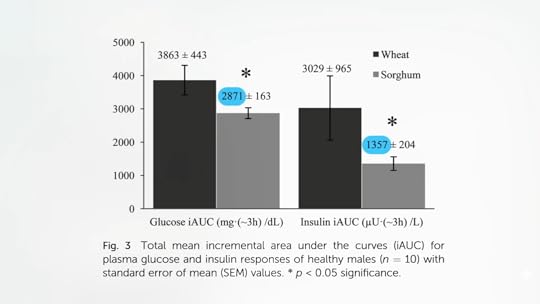
The same type of results were found with people with diabetes. Researchers saw a lower blood sugar spike with sorghum porridge compared to grits, and the participants’ bodies could deal with it with a fraction of the insulin.
So, we need to educate people on how healthy sorghum is—and, some suggest, “develop products that are…healthy, convenient to use, and tasty.” No need! Sorghum is already healthy, convenient, and tasty just the way it is. I just press a single button on my electric pressure cooker with two parts water and one part sorghum, and it’s ready in 20 minutes. You can make a big batch and use it all week just like you would rice.
Of course, there isn’t big money for the food industry when people eat the intact, whole grain. Instead, the industry is looking at sorghum for its “enormous potential for exploitation” in creating “functional foods and food additives.” (Did you know that adding sorghum to pork or turkey patties can decrease their “cardboardy flavor”? Why eat sorghum when you can instead use it to make gluten-free beer?)
It’s funny. When I wrote in How Not to Diet about taxpayer subsidies going to the sugar, corn syrup, oil, and livestock industries to subsidize cheap animal feed to help make Dollar Menu meat, I jokingly asked, “When was the last time you sat down to some sorghum?” Now that we know how good it is for us, maybe we should be taking advantage of the quarter billion dollars the United States is spending to prop up the sorghum industry and sit down to some sorghum after all.
If you missed the previous video, check out Is Sorghum a Healthy Grain?
My How Not to Diet Cookbook is full of delicious and healthful grain recipes. Check it out here.
“Resistant starch”? Learn more about Resistant Starch and Colon Cancer and Getting Starch to Take the Path of Most Resistance.
For more on the benefits of different grains, see related posts below.
February 13, 2025
Is Sorghum a Healthy Grain?
How does sorghum compare with other grains in terms of protein, antioxidants, and micronutrients? And the benefits of red sorghum compared to black and white varieties?
Sorghum is “the Forgotten Grain.” The United States is the top producer of sorghum, “but it is typically not used to produce food for American consumers.” Instead, it’s used mainly “to produce livestock feed, pet foods, household building materials…but it is a preferred grain for human diets in other parts of the world, such as Africa and Asia.” There, it’s been a staple and eaten for thousands of years, making it currently the fifth most popular grain grown after wheat, corn, rice, and barley, beating out oats and rye.
Because sorghum is gluten-free and “can be definitively considered safe for consumption by people with celiac disease,” we’re starting to see it “increasingly used” as actual human food in the United States, so I decided to look into just how healthy it might be. As you can see below and at 0:59 in my video Is Sorghum a Healthy Grain?, it is comparable to other grains when it comes to protein.
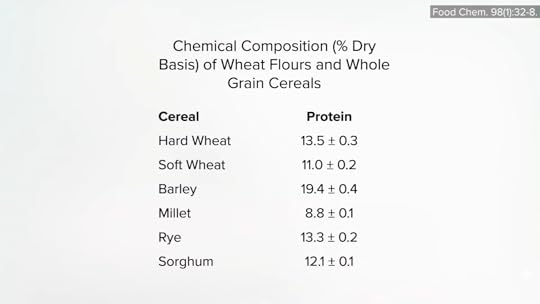
Since when do we have to worry about getting enough protein, though? Fiber is what Americans are desperately deficient in, and sorghum does pull towards the front of the pack, as seen here and at 1:06 in my video.
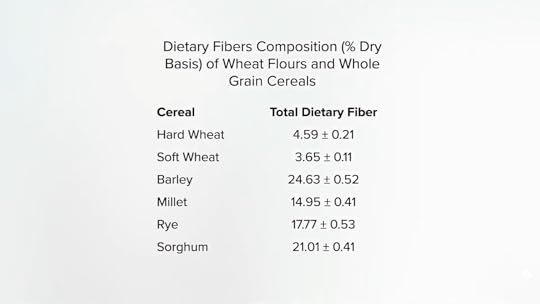
The micronutrient composition is relatively “unremarkable, relative to other cereal grains.” As shown below and at 1:15 in my video, you can see how it rates on minerals, for example.

Where sorghum shines is its polyphenol content. Polyphenols are plant compounds and “their regular consumption has been associated with a reduced risk of a number of chronic diseases, including cancer, cardiovascular disease (CVD), and neurodegenerative disorders.” It’s also been shown to have “a protective effect…on all-cause mortality.” If you compare different grains, sorghum really does pull ahead, helping to explain why its antioxidant power is so much higher, as seen here and at 1:40 in my video.
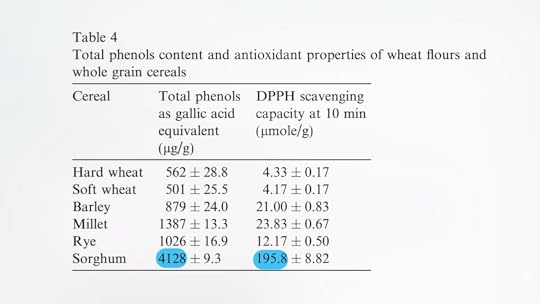
Now, sorghum gets its grainy butt kicked by fruits and vegetables, but when compared to other grains, a sorghum-based breakfast cereal, for example, might have about eight times the antioxidants than a whole wheat-based one. What we care about, though, isn’t antioxidant activity in a test tube, but antioxidant activity within our body.
If you measure the antioxidant capacity of your blood after eating regular pasta, it goes up a little. If you replace 30 percent of the wheat flour with sorghum flour, it doesn’t go up much higher. But, if you eat 30 percent red sorghum flour pasta, the antioxidant capacity in your bloodstream shoots up about 15-fold, as seen below and at 2:22 in my video.
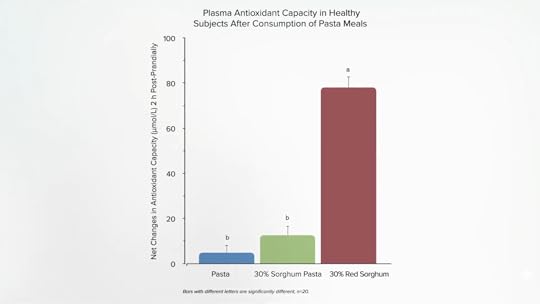
Red sorghum? Yes. In fact, there are multiple types of sorghum—such as black sorghum, white sorghum, and red sorghum. Below and at 2:31 in my video is how they look in grain form (including yellow sorghum).

Red sorghum and especially black sorghum have extremely high antioxidant activity, comparable to fruits and vegetables, as seen here and at 2:41.
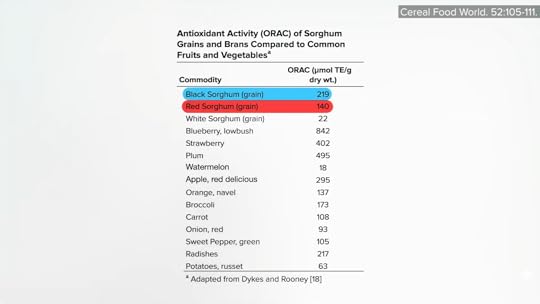
The problem is I can’t find any of the colored sorghum varieties. I can go online and buy red or black rice, purple, blue, or red popping corn, and purple or black barley, but red or black sorghum can be harder to find. White sorghum is widely available for about four dollars a pound, though. Does it have any “unique nutritional and health-promoting attributes”? It’s promoted as “An Underutilized Cereal Whole Grain with the Potential to Assist in the Prevention of Chronic Disease,” according to a study title, but what is the “effect of sorghum consumption on health outcomes”?
As you can see below and at 3:20 in my video, an epidemiological study in China found lower esophageal cancer mortality rates in areas where more millet and sorghum were eaten, compared to corn and wheat, but that may have been due more to avoiding fungal contamination of corn than from any benefit of sorghum itself. Though, it’s possible. “Oats are the only source of avenanthramides,” which give oats some unique health benefits. Similarly, sorghum, even white sorghum, contains unique pigments known as 3-deoxyanthocyanins, which are strong inducers of some of the detoxifying enzymes in our liver and can inhibit the growth of human cancer cells growing in a petri dish, compared to red cabbage, for instance, which just has regular anthocyanin pigments. White sorghum didn’t do much worse than red or black varieties, which have way more of the unique 3-deoxyanthocyanins, so it may just be a general sorghum effect. You don’t know until you put it to the test.
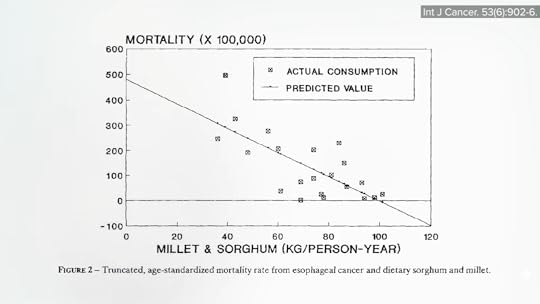
Researchers found that sorghum suppresses tumor growth and metastasis in human breast cancer xenografts. What does that mean? They concluded that sorghum could be used as “an inexpensive natural cancer therapy, without any side effects. We strongly recommend the use of [sorghum] as an edible therapeutic agent as it possesses tumor suppression, migration inhibition, and anti-metastatic effects on breast cancer” for humans. However, xenograft means human breast cancer implanted in a mouse. Yes, the human tumors grew more slowly in the mice-fed sorghum extracts and blocked metastasis to the lung. Yes, sorghum did the same for human colon cancer that, again, was in mice, but that can’t necessarily be translated to how human cancers would grow in humans, since not only do these mice not have a human immune system, they hardly have any immune system at all. They’re bred without a thymus gland, which is where cancer-fighting immunity largely originates. I mean, how else could you keep the mouse’s immune system from rejecting the human tissue outright? But this immunosuppression makes these kinds of mouse models that much more artificial—and that much more difficult to extrapolate to humans.
And that’s a lot of what we see in the sorghum literature—in vitro data from test tubes and petri dishes, and data from rats and mice. There has been “a critical missing piece of the puzzle” needed to link laboratory data to actual benefits in humans. Missing, that is, until now. Thankfully, we now have human interventional studies, which we’ll explore next.
Stay tuned for The Health Benefits of Sorghum.
Should we all be seeking gluten-free grains? See related posts below.
February 11, 2025
Ozempic (Semaglutide) and Other GLP-1 Weight-Loss Drugs: Their Uses, Side Effects, and More
Ozempic and others in a new class of weight-loss drugs have been called “the medical sensation of the decade.” Are they worthy of all the hype?
For a deep dive, please see my primer on this topic. OZEMPIC: Risks, Benefits, and Natural Alternatives to GLP-1 Weight-Loss Drugs is available as an ebook, audiobook, and paperback. You can also view my video series for free on the Ozempic topic page or our YouTube channel. Here are some of the key takeaways.
What Is GLP-1?
A naturally occurring hormone in our body, glucagon-like peptide-1 (GLP-1) plays a role in regulating our blood sugar, appetite, and digestion. Our gastrointestinal tract releases more than 20 different peptide hormones, including GLP-1. The primary stimuli for secreting GLP-1 are meals rich in fats and carbohydrates, and GLP-1’s main action is to signal satiety to the brain. It also slows our digestion. Delaying the rate at which food leaves our stomach not only helps us feel fuller for longer, but also helps with our blood sugar control. When GLP-1 or an agonist (mimic) is dripped into people’s veins, appetite is reduced, leading to markedly reduced food consumption—a decrease in caloric intake by as much as 25 to 50 percent.
About GLP-1 Drugs
Our GLP-1 hormone acts as an appetite suppressant by targeting parts of the brain responsible for hunger and cravings. GLP-1-secreting cells don’t only line our intestines; they’re also in our brains. These new anti-obesity drugs are GLP-1 agonists, mimicking the hormone’s action by binding to GLP-1 receptors.
Our body breaks down GLP-1 so quickly that it hardly makes it even one time around our circulatory system, which is why we can’t just take the hormone directly. A compound was discovered—in the venomous saliva of a lizard called the Gila monster—that mimics GLP-1 but is resistant to breakdown. Using that compound as a template, the first GLP-1 agonist was created and approved for the treatment of diabetes about 20 years ago. Instead of most of it being cleared from the body within two and a half minutes, like native, natural GLP-1, much of the drug remains in the body for two and a half hours. That still means twice-daily injections, though, so then came liraglutide, which lasts all day.
What Is Ozempic?
Eventually, semaglutide was developed and branded as Ozempic, which could be injected just once a week. Ozempic was approved in 2017 to treat diabetes. Within a few years, a daily oral version had been developed, again for diabetes, but researchers running those clinical trials noticed a surprising side effect: People’s appetites diminished.
How Does Ozempic Work?
In a way, GLP-1 agonist drugs work like birth control pills. The Pill mimics placental hormones, thereby tricking our body into thinking we’re pregnant all the time. Ozempic-type drugs mimic GLP-1, thereby tricking our body into thinking we’re eating all the time. That’s how it dials down our hunger drive.
Ozempic for Weight Loss
In the longest trial to date, more than 17,000 individuals were randomized to injections of either high-dose semaglutide or placebo for four years. Overall, those on the drug lost 9 percent more body weight than those in the placebo group, but all the weight was lost in the first 65 weeks. Even though they continued to get injected every week for three more years, they didn’t lose any more weight over the subsequent 143 weeks.
Weight loss tends to plateau because the same amount of effort to cut calories—whether through willpower, drugs, or surgery—is met with growing resistance as ongoing weight loss increasingly activates our feedback control circuit, stimulating our appetite. In the case of the GLP-1 drugs, the weight loss caused by the initial drop in appetite is undercut by an apparent exponential increase in caloric intake as our body ratchets up our hunger again. Within 12 months, this resistance, combined with the decreased caloric needs from being lighter, matches the persistent effort to cut calories, and weight loss plateaus. And, as soon as we stop taking the drugs, our full appetite resumes and we start regaining the weight we initially lost.
The Cost of Ozempic
Wegovy, the high-dose Ozempic used for weight loss, costs up to $1,350 a month, which, again, may have to be paid in perpetuity since any lost weight can pile back on if you stop taking it. So, that could cost more than $16,000 a year if paid out-of-pocket for those whose insurance doesn’t cover it.
Ozempic Side Effects
The most common side effects include nausea, vomiting, diarrhea, and constipation. Gallbladder issues are another side effect; excess cholesterol shed from fat cells can crystalize in our bile like rock candy, forming gallstones.
Rare but serious adverse effects are also emerging. The package inserts for both semaglutide and tirzepatide list a series of “warnings and precautions” that include thyroid tumors, acute inflammation of the pancreas (pancreatitis), acute gallbladder disease, acute kidney injury (that may stem from dehydration due to excess vomiting or diarrhea), allergic reactions, a heightened risk of bottoming out blood sugars while on blood sugar–lowering medications, worsening eye disease for those with type 2 diabetes, an increase in heart rate requiring monitoring, and suicidal thoughts and behaviors.
What Is “Ozempic Face”?
“Ozempic face” is a term used to describe a distorted facial appearance among users of the drug. (Similar accounts have been made of “Ozempic butt.”) Media reports have linked the drug with facial aging, but the sagging appearance has been ascribed simply to the accelerated loss of fat in the face. While this interpretation seems logical, a review of the phenomenon concluded that “this explanation cannot fully account for the markedly accelerated facial aging….” Other factors suspected as being responsible for the appearance of premature facial aging include the loss of facial muscle mass, diminished structural integrity of the skin, and changes in stem cell function and hormonal secretion.
Is Ozempic Safe?
In the first quantitative benefit-versus-harm balance analysis, the researchers concluded that those achieving a 10 percent weight loss had a more than 90 percent chance that the benefits of taking the drugs outweigh the harms, but the opposite was found for individuals achieving only a 5 percent weight loss.
At this time, we don’t know about the long-term harms or benefits because some of these drugs and dosing schedules are so new. To complicate matters, the American Academy of Pediatrics has suggested offering these drugs for teens and even tweens as young as age 12. These drugs work by acting on the brain, so who knows what effect they might have on childhood development and beyond if young people end up taking them for the rest of their lives. Although we now have evidence of near-term benefit over a few years, we cannot assume long-term safety until it has been demonstrated.
Ozempic Alternatives
We don’t need to take GLP-1-mimicking drugs. Not only can the ingestion of a plant-based meal more than double GLP-1 secretion, compared to a meat meal, but plant-based diets can also cause weight loss by boosting our resting metabolic rate and incorporating “calorie-trapping” high-fiber foods that flush calories away. The largest study of people eating strictly plant-based found they are about 35 pounds lighter on average.
When we eat a donut, its fat, sugar, and starch get absorbed quickly, high up, before reaching the part of our digestive tract where we produce most of the hormone that suppresses our appetite, GLP-1. Since the cells that produce GLP-1 in response to calorie exposure are concentrated at the end of our digestive tract, while the majority of the calories we consume are absorbed early on, most calories never make it down far enough. That’s why our appetites aren’t suppressed very much these days. From a GLP-1 standpoint, when we have that donut, it’s like we never ate much of anything. No wonder we reach for donut number two.
Our prehistoric ancestors are believed to have consumed as much as 100 daily grams of fiber, which is more than six times what most of us are getting these days. We evolved eating massive amounts of whole plant foods—the only places fiber is found in abundance. That enabled out natural satiety mechanisms to keep us from overeating. By eating the way nature intended, we can release GLP-1 the way nature intended. That helps explains why in the medical literature, compared to any other way of eating that didn’t involve portion control, a whole food, plant-based diet has been shown to lead to greater average weight loss than any other diet.
For more in-depth information on Ozempic and GLP-1, check out these resources:
my free video series accessible from the Ozempic topic page or our YouTube channel OZEMPIC: Risks, Benefits, and Natural Alternatives to GLP-1 Weight-Loss Drugs , available as an ebook, audiobook, and 100-page paperbackFebruary 6, 2025
How Is Natural Killer Cell Function Boosted by Forest Bathing?
Can the aroma of wood essential oils replicate the immune-boosting effects of walking in a forest?
Studies on the effects of “forest bathing,” or shinrin-yoku in Japanese, “a traditional practice characterized by visiting a forest and breathing its air,” have found it “can induce a significant increase in the number and activity of natural killer (NK) cells” that can last as long as a month. And because natural killer cells are one of the ways our body fights cancer by killing off tumor cells, the “findings suggest that visiting forest parks may have a preventive effect on cancer generation and progression.” How? “Why did the forest environment increase human NK activity? What kind of factors in the forest environment activated human NK cells?” What is it about the forest environment?
One thought is that the boost may be related to a reduction in stress. If you measure the amount of adrenaline flowing through people’s systems, did spending time in a forest—but not in a city—lower adrenaline levels? Yes, as you can see at 0:58 in my video Why Does Forest Bathing Boost Natural Killer Cell Function?.

However, if you drip some adrenaline on human blood cells in a petri dish, there does not appear to be any effect on NK cells. The stress hormone cortisol, on the other hand, dramatically suppresses natural killer cell activity, as shown below and at 1:09 in my video. So, might being in the forest lead to less stress and less cortisol, which releases the natural killer cells under its thumb, giving us a boost?

We know being surrounded by nature can decrease levels of cortisol in our saliva, but what about our bloodstream? Researchers found a significant drop in the stress hormone after a single-day trip to the forest. A week later, cortisol was normalizing, as you can see here and at 1:30 in my video, but the forest’s effects sometimes appeared to last an entire month. Anything else that could cause a longer-term immune system change?

Maybe we’ve been missing some of our “Old Friends.” If you sample outdoor air, you can pick up an abundance of microorganisms from the soil and water that float around—but are absent from indoor air. (Indoor air is dominated by organisms that either live on us or try to attack us.) So, on a day-to-day basis, in terms of keeping our immune system on ready alert, it “might not be sufficient to encounter only the biased microbiota of the modern synthetic indoor environment that lacks some of the Old Friends and probably bears little resemblance to the microbiota we encountered throughout our evolutionary history,” the microbes we evolved to live with over millions of years.
Or perhaps it’s the plants themselves. Maybe it’s the aroma of the forest. Trees produce aromatic volatile compounds called phytoncides, like pinene, which we can breathe into our lungs when we’re in the forest. Do these compounds actually get into our bloodstream? Indeed, after spending one hour in the woods, we get about a sixfold increase in pinene levels circulating throughout our system. To fully connect all the dots, phytoncides like pinene—those essential oils from wood—would then have to induce human natural killer cell activity. And guess what? The study title gives it away: “Phytoncides (Wood Essential Oils) Induce Human Natural Killer Cell Activity.” If you put natural killer cells in a petri dish with leukemia cells, our NK cells can wipe out some of the cancer cells. But, if you add a whiff of cypress, white cedar, eucalyptus, or pine, the cancer cells don’t stand a chance, as shown below and at 3:14 in my video.

A combination of wood aromas improved the recovery of mice put through the wringer, but this is the study I was looking for: “Effect of Phytoncide from Trees on Human Natural Killer Cell Function.” If we want to know if the magic ingredient is the fragrance of the forest, then let’s see if we can get that same boost in natural killer cell activity by just vaporizing some essential oil from one of the trees into a hotel room overnight. It worked! There was a significant boost in natural killer cell activity, as seen here, and a 3:40 in my video.

Only NK activity was boosted, though, rather than the number of the natural killer cells, and being in an actual forest can elevate both. So, perhaps it’s a combination of the tree fragrance and the lower cortisol levels working together.
Ironically, these phytoncide compounds are part of the tree’s own immune system, which we may be able to commandeer. As you can see at 4:05 in my video, researchers speculate that these compounds may be playing a role in the fact that more heavily forested regions in Japan appear to have lower death rates from breast cancer and prostate cancer. Indeed, being in nature has been found to be an “important coping strategy among cancer patients,” but it may help us cope better, thanks to the fragrance of trees.
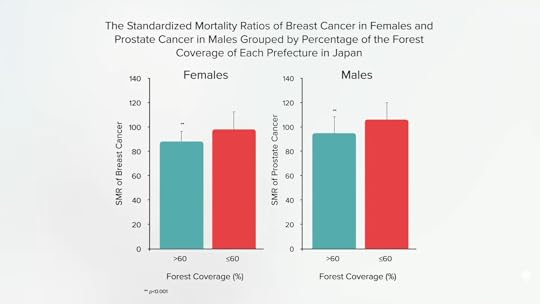
Spending time in a forest significantly increases NK cell activity. In my previous blog, I discussed Boosting Anticancer Immunity with Forest Bathing.
You may recall that I’ve touched on this topic before. See Are There Health Benefits of Spending Time in Nature?.
For more on aromatherapy, check out the related posts below.
February 4, 2025
Forest Bathing to Boost Anticancer Immunity
Natural killer cells are one of the ways our body fights off cancer, and visiting a forest can induce a significant increase in both their numbers and their activity.
I’ve previously shown how exposure to nature can have self-reported psychological benefits, but there was a dearth of data on changes in objective measurements, so I was excited to see this paper on the effects of forest bathing, “a traditional practice characterized by visiting a forest and breathing its air,” on levels of the stress hormone cortisol in the participants’ saliva.
The level of cortisol in our saliva is considered an indicator of our stress level, and study participants’ salivary cortisol levels were significantly lower after walking in a forest or even just hanging out in one (“forest watching”), compared to walking or just being in a city, as you can see at 0:49 in my video Boosting Anticancer Immunity with Forest Bathing.

However, the same effect was found before they went to the forest, too. Indeed, “forest bathing, in particular forest watching, was associated with significantly lower cortisol levels both before and after this practice if compared with visiting an urban area.” Therefore, it appears that just the thought of spending time in a forest relieves stress. So, “when comparing the effects of forest bathing versus urban visiting, the anticipated placebo effect…may play a more important role in influencing cortisol [stress] levels than the actual experience” of being in the forest. I was ready to dismiss this as just another nebulous psychological effect until I read this: “Studies on the effects of ‘Shinrin-yoku’ [forest bathing] on the immune function showed that visiting a forest can induce a significant increase in the number and activity of natural killer (NK) cells,” one of the ways our body fights off cancer. That got my attention.
It all started with this study: Twelve men were taken on a long weekend trip to walk in the forest, and nearly all of them (11 out of 12) showed higher natural killer cell activity afterward. It wasn’t just a little increase either; they had about a 50 percent increase in NK cell activity after the trip compared to before they went to the forest, as you can see at 2:00 in my video.

Now, exercise alone can affect immune function, but “there were no significant differences in walking steps before and during the trip.” The study participants were just walking in a forest instead. However, they were taken on a trip somewhere, which introduced other variables, so what about randomizing them to go on a city trip versus a forest trip? If there were some special forest effect, how long would it last? Do you have to walk in the forest every day? Before jumping into all that, let’s first see if it works in women, too.
This study had the same kind of set-up, and the same kind of results: a significant boost in natural killer cell activity from walking in the woods. What’s more, this time, the participants were retested a week later, and their natural killer cell activity was still up. When they were retested a month after the trip their levels were back to baseline, as you can see at 2:45 in my video.

So, walking in the woods once a week should do it, but the study involved a multi-day trip. Who can go to the forest all weekend, every weekend? How about just a day trip? The title gives it all away: “A Day Trip to a Forest Park Increases Human Natural Killer Activity and the Expression of Anti-Cancer Proteins in Male Subjects.” The same results and the same big jump measured the day after the trip compared to before and with the same staying power, as you can see at 3:08 in my video. And, natural killer cell activity was still boosted a week later. “This suggests that if people visit a suburban forest park once a week on a day trip, they may be able to maintain increased NK activity” and a boost in anticancer immune function.
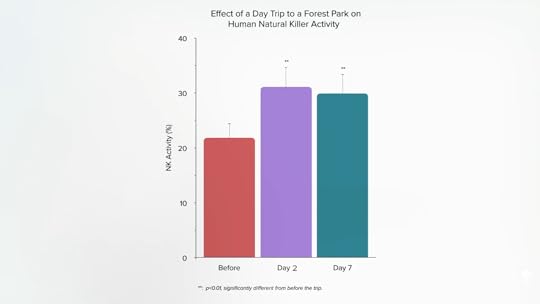
I’m still not convinced, though. How can you attribute the benefit to the forest itself, when all you have are before and after data? To make the case that nature had anything to do with it, you’d need a control group of study participants who took the same kind of trip but went somewhere else instead. And here we go. Again, the study title says it all: “Visiting a Forest, but Not a City, Increases Human Natural Killer Activity and Expression of Anti-Cancer Proteins.” By the end of the forest trip, the participants experienced a boost of 80 percent in NK activity after forest bathing, compared to only a 10 percent bump for the city walkers, as shown below and at 3:58 in my video.
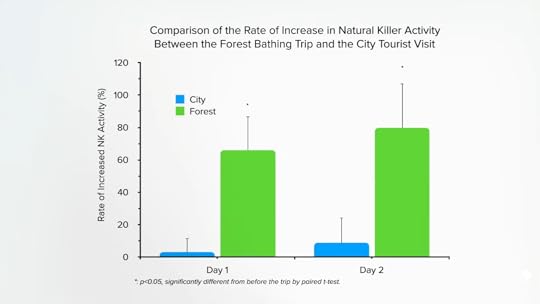
Both trips were matched for physical activity, alcohol, and sleep, too—other factors and behaviors that can affect immune function. So, we’ve got confirmation of boosted immunity, but only on the forest trip, “indicating that forest bathing does indeed enhance human NK activity.” Moreover, the researchers found that “the increased NK activity and numbers of NK cells induced by a forest bathing trip lasted more than 7 days, even 30 days, after the trip.” As you can see below and at 4:26 in my video, NK activity was still up a week later and even a bit up a month later. “This suggests that if people visit a forest once a month, they may be able to maintain increased NK activity. This may be important in health promotion and preventive medicine.”

Now that we know that forest bathing induces a real effect, the next question is, Why? What is it about forests that give us the boost? (You can imagine Big Pharma wondering if it can be made into a pill.) We’ll find out next.
The video I mentioned at the start is Are There Health Benefits of Spending Time in Nature?.
Stay tuned for the follow-up post: Why Does Forest Bathing Boost Natural Killer Cell Function?.
For other ways to improve immune function, check out related posts below.
January 31, 2025
Preorder The How Not to Age Cookbook
I’m thrilled to announce that pre-orders are now open for The How Not to Age Cookbook, coming out on April 22. This much-anticipated culinary companion to my New York Times Best Seller, How Not to Age, is a beautifully-illustrated cookbook with more than 100 recipes developed again with Robin Robertson to help you age healthfully and vibrantly. Each of these simple, nutrition-packed dishes uses ingredients that have been proven to promote a healthy lifespan, and inspiration has been drawn from the places around the world where people traditionally live the longest.
For instance, the bright anthocyanin pigments in berries are thought to account for their benefits for our cognitive function, eyesight, inflammation, blood sugar, artery function, and cholesterol, so eat your berries, drink hibiscus tea, and enjoy savory sources like purple sweet potatoes. When it comes to our joints, strawberries, ginger, and turmeric, for example, have been found to help with osteoarthritis of the knees, a leading cause of disability in older adults.
Get a Signed BookplateOnce you pre-order your copy of The How Not to Age Cookbook, make a donation using this form and, as a token of my appreciation of your support, I’ll sign a bookplate that will be sent to you. The bookplate will fit perfectly into the front cover of the book and makes a great keepsake for yourself or an extra special gift for a loved one. As always, thank you for your support and dedication to the latest in evidence-based nutrition. Only a limited number of bookplates are available, so be sure to pre-order my new cookbook and make a donation today!
While you wait for the book to arrive, check out my anti-aging videos, stay tuned to our social media for some recipes, and try this delicious Tempeh and Mushroom Chili.
Tempeh and Mushroom Chili with Corn and CilantroMakes 6 servings
 Chopped mushrooms and tempeh add great texture and heartiness to this flavorful chili that bursts with kidney beans, corn kernels, and cilantro. This recipe calls for cremini mushrooms because they hold up well in stews and chili. If unavailable, you can substitute white button mushrooms.
Chopped mushrooms and tempeh add great texture and heartiness to this flavorful chili that bursts with kidney beans, corn kernels, and cilantro. This recipe calls for cremini mushrooms because they hold up well in stews and chili. If unavailable, you can substitute white button mushrooms.
Steam the tempeh in a steamer basket over a saucepan with about 2 inches of boiling water for 10 minutes, then drain, coarsely chop, and set aside.
Heat ¼ cup of water in a large saucepan over medium heat. Add the onion and bell pepper, cover, and cook until softened, about 5 minutes.
Add the miso mixture and garlic, then stir in the reserved tempeh, mushrooms, chili powder, oregano, black cumin, and pippali. Cook until fragrant, about 1 minute. Add the tomatoes, beans, and corn.
Cover and simmer over low heat, stirring occasionally, until the chili is thick and flavorful, about 30 minutes. Stir in the cilantro. If the chili is too thick, stir in a little water. Serve hot.
As always, all proceeds I receive from all of my books are donated directly to charity.
January 30, 2025
An Ideal Waist Size
The book Dieting Makes You Fat was published originally in the 1980s and then repeatedly republished. Since most people who lose weight go on to regain it, there is a concern that there may be adverse health consequences of “yo-yo dieting.” This idea emerged from animal studies that, for example, showed the detrimental effects of starving and refeeding obese rats. This captured the media’s attention, leading to “a pervasive view found in many media outlets” about “the ‘dangers’ of weight cycling,” discouraging people from even trying to lose weight.
But even the animal data are inconclusive. For example, weight-cycling mice make them live longer. Most importantly, a review of the human data concluded that “evidence for an adverse effect of weight cycling appears sparse if it exists at all.” Bottom line? “Yo-Yo Dieting Is Better than None.”
Ideally, we’d be at a body mass index (BMI) of 20 to 22. (You can see a unisex BMI chart below and at 1:05 of my video What’s the Ideal Waist Size?.) However, BMI doesn’t take into account the composition of the weight. Bodybuilders are heavy for their height, for instance, yet can be extremely lean. The gold standard measure of obesity is body fat percentage, but an accurate calculation can be complicated and expensive. All you need to measure BMI is height and weight, but it may underestimate the true prevalence of obesity.

The World Health Organization defines obesity as a body fat percentage above 25 percent in men or 35 percent in women. At a BMI of 25, which is considered just barely overweight, body fat percentages in a representative sample of U.S. adults varied from 14 percent to 35 percent in men and 26 to 43 percent in women. So, you could be at a “normal” weight but actually obese. Using the BMI cutoff for obesity, only about one in five Americans was obese in the 1990s, but based on their body fat, the true proportion even back then was closer to 50 percent. Half of Americans are not just overweight, but obese.
So, using only BMI, doctors may misclassify more than half “of patients with excess body fat as being normal or just overweight and…miss an opportunity to intervene and reduce health risk in such individuals.” What’s important is not the label, though, but the health consequences. Ironically, BMI appears to be an even better predictor of cardiovascular disease death than body fat percentage. That suggests that excess weight from any source—whether fat or lean—may not be healthy in the long run. The lifespan of bodybuilders does seem to be cut short. They have about a one-third higher mortality rate than the general population. The average age of death is around 48 years, but this may be due in part to the toxic effects of anabolic steroids on the heart, as shown below and at 2:57 in my video.
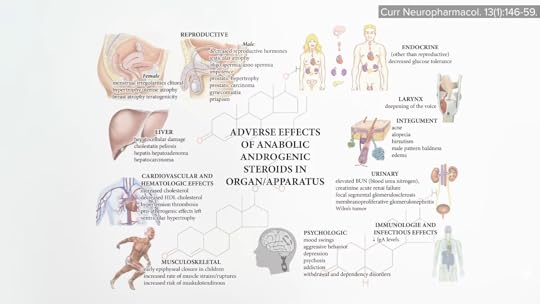
Pre-eminent nutritional physiologist Ancel Keys (after which “K-rations” were named) suggested the mirror method: “If you really want to know whether you are obese, just undress and look at yourself in the mirror. Don’t worry about our fancy laboratory measurements; you’ll know!” All fat is not the same, though. There is the pinchable superficial flab that we may see jiggling about our body, and then there’s the riskier, deeper visceral fat that coils around and infiltrates our internal organs. Measuring BMI is simple, cheap, and effective, but it does not take into account the distribution of fat on the body, whereas waist circumference can provide a measure of the deep underlying belly fat.
Both BMI and waist circumference can be used to predict the risk of death due to excess body fat, but, as you can see below and at 3:53 in my video, even at the same BMI, there appears to be nearly a straight-line increase in mortality risk with widening waistlines. Someone who has “normal-weight central obesity”—meaning someone who isn’t overweight, according to their BMI, but is fat around the middle—may have up to twice the risk of dying compared to someone who is obese, according to their height and weight. This is why the current guidance recommends measuring both BMI and waist circumference. This may be especially important for older women. “Between the ages of 25 and 65, the average woman will lose approximately 13 pounds of bone and muscle mass, while her visceral fat will nearly quadruple in size….” (Men tend to only double their visceral fat.) So, even if a woman doesn’t gain any weight according to the bathroom scale, she may be gaining fat.

What is the waistline cut-off? Increased risk of metabolic complications starts at an abdominal circumference of 31.5 inches (80 cm) in women and 37 inches (94 cm) in most men, though it is closer to 35.5 inches (90 cm) for South Asian, Chinese, and Japanese men. The benchmark for substantially increased risk starts at about 34.5 inches (88 cm) for women and 40 inches (102 cm) for men. Once you get above an abdominal circumference of about 43 inches (110 cm) in men, mortality rates shoot up about 50 percent compared to men with 8-inch-smaller (20-cm-smaller) stomachs, and women suffer 80 percent greater mortality risk with waists of 37.5 inches (95 cm) compared to 27.5 inches (70 cm). The reading of a measuring tape may translate into years of one’s lifespan.
The good news is the riskiest fat is the easiest to lose. Our body appears smart enough to preferentially shed the villainous visceral fat first. Although it may take losing as much as 20 percent of our weight to realize significant improvements in quality of life for most individuals with severe obesity, disease risk drops almost immediately. At 3 percent weight loss, which is only 6 pounds (2.7 kg) for someone weighing 200 pounds (91 kg), for instance, blood sugar control and triglycerides start to improve. At 5 percent, blood pressure and cholesterol improve. Our risk of developing diabetes may be cut in half by just a 5 percent weight loss, about 10 pounds (4.5 kg) for someone starting at 200 pounds (91 kg), for instance.
This is the final video in this series on obesity and weight. If you missed any of the others, see related posts below.
I cover all of this and more at length in my book How Not to Diet, and its companion, The How Not to Diet Cookbook, has more than 100 delicious Green-Light recipes that incorporate some of my 21 Tweaks for the acceleration of body fat loss.
January 28, 2025
An Ideal BMI
Is there a unisex chart for optimal weight based on height?
We seem to have become inured to the mortal threat of obesity. If you go back in the medical literature almost a quarter of a century ago when obesity wasn’t run-of-the-mill, the descriptions are much grimmer: “Obesity is always tragic, and its hazards are terrifying.” Not just obesity, though. Of the four million deaths attributed to excess body fat each year, nearly 40 percent of the victims are overweight, not obese. According to two famous Harvard studies, weight gain of as little as 11 pounds (5 kg) from early adulthood through middle age increases the risk of major chronic diseases, such as diabetes, cardiovascular disease, and cancer. The flip side, though, is that even modest weight loss can have major health benefits.
What is the optimal body mass index, commonly known as BMI? The largest studies in the United States and around the world found that having a BMI of 20 to 25 is associated with the longest lifespan. Put all the best available studies with the longest follow-up together, and that can be narrowed down even further to a BMI of 20 to 22. That would be about 124 to 136 pounds (56 to 62 kg) for someone who’s five-foot-six (168 cm), as you can see below and at 1:22 in my video What’s the Ideal BMI?.

Even within a “normal” BMI range, the risk of developing chronic diseases, such as type 2 diabetes, heart disease, and several types of cancer, starts to rise towards the upper end—starting as low as a BMI of 21. BMIs of 18.5 and 24.5 are both considered to be within the “normal” range, but a BMI of 24.5 may be associated with twice the risk of heart disease compared to a BMI of 18.5.
Below and at 2:05 in my video is a graph of diabetes risk and BMI among women. There is a fivefold difference in diabetes rates within the so-called ideal range with a BMI under 25.

Just as there are gradations of risk within a normal BMI range, there is a spectrum within obesity. Class III obesity (BMI over 40) can be associated with the loss of a decade or more of life. At a BMI above 45, for example, a person standing at 5’6″ (168 cm) and weighing 280 pounds (127 kg), life expectancy may shrink to that of a cigarette smoker.
However, “skeptics have argued that the consequences of rising obesity levels have either been greatly exaggerated or are unclear.” A “motley crew,” “obesity skeptics are made up of a kaleidoscope of interest groups…includ[ing] feminists, queer theorists, libertarians, far right-wing conspiracy types and new ageists.” It “has also been popular on far right-wing, pro-gun, pro-America websites where the idea that obesity alarmists are nanny-state communists who simply want to stop us from having fun plays well….”
Unlike activists who organized to raise consciousness and stamp out the AIDS epidemic, for example, some in the size acceptance movement appear to have the opposite goal and “have called for less public awareness and intervention regarding obesity,” less treatment of the problem. I’m all for fighting size stigma and discrimination—I have a whole section on weight stigma in my book How Not to Diet—but the adverse health consequences of obesity are an established scientific fact.
Can’t you be fat but fit? In a study of more than 600 centenarians, only about 1 percent of the women and not a single one of the men were obese. There does appear to be a rare subgroup of individuals who are obese and do not suffer the typical metabolic costs, such as high blood pressure and cholesterol. This raises the possibility that there may be such a thing as “benign obesity” or “metabolically healthy obesity.” It may just be a matter of time, though, before the risk factors develop. Even if they don’t, though, when followed long enough, even “metabolically healthy obese adults” are at increased risk of diabetes, as well as increased risk of fatty liver disease. They are also at greater risk of cardiovascular events, such as heart attacks, and/or premature death, as shown below and at 4:20.

Bottom line? There is “strong evidence that ‘healthy obesity’ is a myth.”
Many “fat activists” try to downplay the risks of obesity, even as they may be among “the greatest victims” of the epidemic. “Leading fat acceptance activist Lynn McAfee, who is director of medical advocacy for the Council on Size and Weight Discrimination and takes part in obesity conferences and government panels on obesity,” is quoted as saying, “‘I’m not actually particularly that interested in [health] and God I hate science….”
If you missed the previous blog posts in this series on obesity, see related posts below.
The final video in this series is What’s the Ideal Waist Size?.



